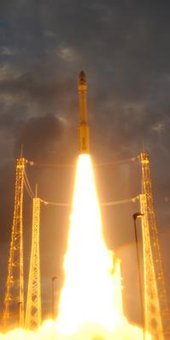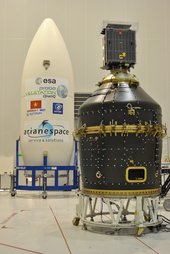First raw image from the Proba-V satellite, acquired over France’s west
coast on 15 May 2013. The image was generated using the three VNIR
bands, blue, red and near-infrared (NIR) superposed, the green being
replaced by the NIR. It has not yet been radiometrically or
geometrically corrected. Less than a cubic metre in volume, the
miniaturised ESA satellite is tasked to map land cover and vegetation
growth across the entire planet every two days.
Proba-V opens its eyes
Earth watcher Proba-V is in good health following its launch last week.
The Vegetation imager has been switched on and the first image has been
captured over western France.
The miniature satellite is designed to map land cover and vegetation
growth across the entire planet every two days. The data can be used for
alerting authorities to crop failures or monitoring the spread of
deserts and deforestation.
The satellite’s vegetation imager was switched on Wednesday in time to
get a glimpse of France’s coast along the Bay of Biscay and the lush
interior. The data were then sent down to ESA’s Redu centre in Belgium.
Launched by a Vega rocket from French Guiana in the early hours of 7 May
along with two other satellites, Proba-V was the first of the three
passengers to be deployed into its Sun-synchronous near-polar orbit at
820 km altitude, just 55 minutes after launch.
The effort to bring the minisatellite to life began immediately – known
as the Launch and Early Operations Phase, or LEOP, overseen from Redu,
where the satellite is controlled from and monitored during its mission.
“The first LEOP milestone was to check the first signs of life from the satellite as it flew over the ESA ground station at Kourou 40 minutes after separation,” explained Karim Mellab, Proba-V Project Manager.
“Then a full telemetry session confirmed the stabilisation of the satellite’s attitude, or pointing direction. The onboard computer used ‘magnetorquers’ – basically magnets interacting with Earth’s magnetic field – to control the satellite’s attitude and compensate for the spin imparted by the separation.
“Since then, we have been checking the various subsystems one by one, confirming that they have made it through the stress of launch in working order.
“These initial checks are now being followed by a diligent commissioning of every single detail of the overall system platform, instrument and technology demonstration payloads, which will take the next few months.”
This will include a careful cross-calibration of the Vegetation imager with the previous generation of the instrument, operating aboard France’s Spot-5 satellite, to ensure data compatibility.
“The first LEOP milestone was to check the first signs of life from the satellite as it flew over the ESA ground station at Kourou 40 minutes after separation,” explained Karim Mellab, Proba-V Project Manager.
“Then a full telemetry session confirmed the stabilisation of the satellite’s attitude, or pointing direction. The onboard computer used ‘magnetorquers’ – basically magnets interacting with Earth’s magnetic field – to control the satellite’s attitude and compensate for the spin imparted by the separation.
“Since then, we have been checking the various subsystems one by one, confirming that they have made it through the stress of launch in working order.
“These initial checks are now being followed by a diligent commissioning of every single detail of the overall system platform, instrument and technology demonstration payloads, which will take the next few months.”
This will include a careful cross-calibration of the Vegetation imager with the previous generation of the instrument, operating aboard France’s Spot-5 satellite, to ensure data compatibility.
Less than a cubic metre in volume, Proba-V is a miniaturised ESA
satellite tasked with a full-scale mission: to map land cover and
vegetation growth across the entire planet every two days.
Proba-V is flying a lighter but fully functional redesign of the Vegetation imaging instruments previously flown aboard France’s full-sized Spot-4 and Spot-5 satellites, which have been observing Earth since 1998.
The minisatellite will provide data to the instrument’s worldwide user community of scientists and service providers as soon as its orbital commissioning – including cross-checks with Spot-5’s Vegetation instrument – is complete and the mission is turned over from ESA’s Directorate of Technical and Quality Management to the Agency’s Earth Observation Programme.
Proba-V is flying a lighter but fully functional redesign of the Vegetation imaging instruments previously flown aboard France’s full-sized Spot-4 and Spot-5 satellites, which have been observing Earth since 1998.
The minisatellite will provide data to the instrument’s worldwide user community of scientists and service providers as soon as its orbital commissioning – including cross-checks with Spot-5’s Vegetation instrument – is complete and the mission is turned over from ESA’s Directorate of Technical and Quality Management to the Agency’s Earth Observation Programme.
Vital uses of Proba-V Vegetation data include day-by-day tracking of
extreme weather, alerting authorities to crop failures, monitoring
inland water resources and tracing the steady spread of deserts and
deforestation.
Proba-V is the latest addition to the Proba family of small space
missions, giving flight experience to promising European technologies.
So along with hosting its main instrument, Proba-V also provides early
test flights for a variety of advanced ‘guest payloads’.
These comprise a detector to track aircraft in flight around the world, two radiation monitors, a communication amplifier based on high-performance semiconductor gallium nitride and an experiment testing fibre optics for space.
These comprise a detector to track aircraft in flight around the world, two radiation monitors, a communication amplifier based on high-performance semiconductor gallium nitride and an experiment testing fibre optics for space.
VEGA
| Main Data | Vega |
|---|---|
| Height | 30 m |
| Diameter | 3 m |
| Liftoff mass | 137 tonnes |
| Payload mass* | 1500 kg |
Although there is a growing tendency for satellites to become larger, there is still a need for a small launcher to place 300–2000 kg satellites, economically, into the polar and low-Earth orbits used for many scientific and Earth observation missions.
Europe’s answer to these needs is Vega, named after the second brightest star in the northern hemisphere. Vega will make access to space easier, quicker and cheaper.
Costs are being kept to a minimum by using advanced low-cost technologies and by introducing an optimised synergy with existing production facilities used for Ariane launchers.
Vega is a single-body launcher with three solid-propellant stages and a liquid-propellant upper module for attitude and orbit control, and satellite release. Unlike most small launchers, Vega is able to place multiple payloads into orbit.
Development of the launcher started in 1998. The first Vega lifted off on 13 February 2012 on a flawless qualification flight from Europe’s Spaceport in French Guiana, where the Ariane 1 launch facilities have been adapted for its use.
The second Vega launch took place on 7 May 2013 from French Guiana. It
marks the transition into commercial exploitation while still completing
its qualification. This launcher with increased capabilities and
flexibility is designed to meet the demands of the launchers market.
The extended capabilities of Vega beyond the mission that was performed
in the VV01 qualification flight have been made possible in part by the
addition of Vespa (VEga Secondary Payload Adapter). Vespa allows for
multiple payloads and their deployment into different orbits.
Compared to the first Vega launch, with VV02 there was a change in both inclination and orbit for the satellites. This is a complex procedure and resulted in a much longer mission – at 160 minutes it is more than double that of VV01.
Proba-V was the first payload released by Vespa into a Sun-synchronous polar orbit at 820 km altitude and an inclination of 98.73°. At this point, the Vespa adapter separated and Vega then, through a series of five burns and coasts, moved into a second orbit at 668 km altitude and an inclination of 98.13° for the second deployment of the two remaining payloads.
A final burn will deorbit the upper stage to ensure that it does not remain as a debris threat.
In addition to the Vespa adapter, this second Vega launcher also has new flight software.
To receive telemetry during the early phase of the flight, a new ground station has been built in the north of French Guiana.
This was the first Vega launch operated by Arianespace on behalf of ESA, although ESA still remains responsible for the mission.
* Launch in circular orbit, 90°inclination, 700 km
Compared to the first Vega launch, with VV02 there was a change in both inclination and orbit for the satellites. This is a complex procedure and resulted in a much longer mission – at 160 minutes it is more than double that of VV01.
Proba-V was the first payload released by Vespa into a Sun-synchronous polar orbit at 820 km altitude and an inclination of 98.73°. At this point, the Vespa adapter separated and Vega then, through a series of five burns and coasts, moved into a second orbit at 668 km altitude and an inclination of 98.13° for the second deployment of the two remaining payloads.
A final burn will deorbit the upper stage to ensure that it does not remain as a debris threat.
In addition to the Vespa adapter, this second Vega launcher also has new flight software.
To receive telemetry during the early phase of the flight, a new ground station has been built in the north of French Guiana.
This was the first Vega launch operated by Arianespace on behalf of ESA, although ESA still remains responsible for the mission.
* Launch in circular orbit, 90°inclination, 700 km
Last update: 10 May 2013
Vega (Vettore Europeo di Generazione Avanzata)
Guillermo Gonzalo Sánchez Achutegui
ayabaca@gmail.com
ayabaca@yahoo.com
ayabaca@yahoo.com

 (3.55 MB
(3.55 MB



No hay comentarios:
Publicar un comentario